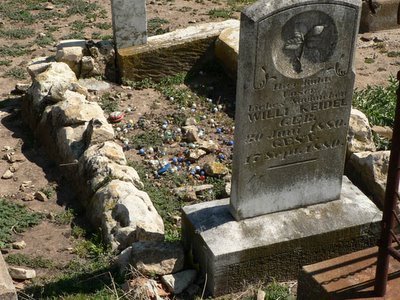The Republican propaganda apparatus is a lovingly crafted and astonishingly successful deception-machine, a work of perverse genius in its intellect-damping automatically generated fog of logical flaws rolling out like stage smoke at a bad rock concert, with flashing lights and a thunder of rhetorical cheap shots amped-up to seizure-induction levels, all deployed in the service of lies, superstition, oppression, and avarice, never mind if the stage fireworks should set the house on fire and kill the audience. Swiftboating has become part of the language because, unfortunately, it has become part of the Republican business model. The world has seen nothing like it since Goebbels, whose work, absent the technology Karl Rove has at his fingertips, seems primitive by comparison.
Apparently no part of the world of reality can be left unassailed. Having discovered they can successfully cast doubt on the extremely heroic military service of John Kerry and Max Cleland, and do so on behalf of the likes of someone whose whereabout during his last two years of his entirely stateside National Guard obligation is completely unknown, having been expunged from the historical record, their hubris leads them to think they can do anything, perhaps even cast doubt on science itself--which seems to be their current project.
As the evidence for catastrophic global warming leads the scientific community to near-unanimity on both its actuality and danger, Republicans respond with official doubt and obstinate denial. Global warming "skeptics" come out of the woodwork with bad mathematics and incorrect data to muddy the water. It's bizarre, as if Karl Rove were both recreation director and de-facto captain of the Titanic (the de-jure captain being on vacation in his cabin) insisting to the last that there are no icebergs in the North Atlantic, and somehow succeeding, with the help of acolytes in the crew, in convincing everyone in the wheelhouse, as well as on the ballroom dancefloor, that this is so. As crazy and stupid as such a smoke and mirrors project would be, you have to realize that we are the passengers, full steam ahead to a Republican future. And of course the Republican crew will shove the women and children out of the lifeboats when reality reasserts itself, as it will.
But there is no more a spare planet for them than for us, to evacuate to. I guess that's justice, but that's not going to be a consolation to most of us.
Peak oil is going to be soon, if it is not here already, and Republican car executives want to build more Hummers, better gas mileage and public transit be damned. And it's all over the country. Here is my part of Texas, the Republicans have hammered all efforts at light rail, and have ramrodded a toll road project that will saddle our children with crushing debt 20 years out. You could laugh if these people were not so dangerous.
This list of their anti-reality projects is endless, and they seem confident in their expectation that the country, and the world, being boiled like frogs in a stew of rightwing irrationality, will not notice.
Just this morning I was reading about the smear machine cranking up to discredit a New York Times science writer named Kenneth Chang, who actually looked at the names on a list of 514 scientists and engineers who signed a Discovery Institute "petition" professing doubt about evolution. A large number of the signers are evangelical Christians. Only about a quarter of the signers are biologists. Almost none of those biologists are working in fields related to evolutionary theory.
The statement they signed said, "We are skeptical of claims for the ability of random mutation and natural selection to account for the complexity of life. Careful examination of the evidence for Darwinian theory should be encouraged." Actually, all scientists agree with the second sentence. The first is vague and is obviously pitched to the unwillingness of many scientists to accept a full and settled account of anything, science always being a work in progress. Indeed, anybody really knowledgeable about modern evolutionary theory could readily sign the whole statement, simply because random mutation and natural selection are no longer considered the only mechanisms of evolution in contemporary biology.
But no such knowledgeable people seem to be discernible among the actual signers.
What Chang discovered was that a large percentage of the signers are not scientists at all, rather are engineers or physicians, and none are prominent biologists, and indeed of the 20 scientists he actually interviewed we see some odd ducks. One, a cell biologist, does not accept the evidence from physics and astronomy of a great age for the universe. He believes in the biblical account of creation instead. Another, a chemist and self-professed Jew for Jesus, believes the Darwinian evolutionary account is incomplete, but says he may accept evolution with additional evidence.
Discovery Institute could point to only 2 signers, of the 514, who were not fundamentalist Christians. One, a "philosopher and mathematician," works for the Discovery Institute. The other said in the interview with Chang, "I signed [the petitition] in irritation," claiming biologists were unfairly squelching alternative avenues of research. "They deserve to be prodded, as it were," he said "It was my way of thumbing my nose at them." (quotes from the NYT.)
So, all in all, Chang discovered there was less than meets the eye here.
A pretty innocuous article. But, whoa, suddenly there is a rightwing campaign to discredit Chang's fairness and incidentally feed the flames of the general Republican-base hatred of the New York Times. And the campaign proceeds, naturally, by attacking what Chang did not say. John West, of the Discovery Institute, claims:
While Chang's story conveys the clear impression that scientists who support Discovery's Dissent from Darwin statement are motivated by religion rather than science, Chang has now admitted in an interview that 75% or more of the scientists he interviewed did not fit this description. (boldface in original)
Chang could easily admit this, since the article itself did not say the the signers were so motivated. Karl Rove would be proud, making it sound like the reporter is backtracking on something he in fact never, in reality, said.
Specifically, Chang said that 5 of the 20 scientists he interviewed were Biblical literalists whose religious views strongly influenced their skepticism. The Discovery Institute then, in their hatchet job on Chang's article, managed to construe Chang's reiteration of these figures (when they later talked to Chang) as an "admission" that 75% of the 20 were _not_ so motivated. Thus they end up saying that Chang "admits" that a claim he never made is not true. Pretty sleazy.
Chang's article is now behind the pay-to-view NYT archive. The Discovery Institute's dog and pony show about it is all over the Christian webosphere. A typical instance, on a site called
www.twoorthree.net, is the headline "summary" of the Discovery Institute slime attack on Chang, "NYT Journalist Admits He Lied About the 500 ID Scientists." The original DI hatchet job could not get away with _that_ claim, but once it gets into Republican Unrealityland, the story, um, evolves. Mutates, as it were.
This Chang business that set me off this morning is trivial, of course, but the very fact that the right wing is mounting its attack on trivial fronts as well as important ones (global warming is a really important issue) shows they are in a full court press against reality itself. Reality always wins, but in the meantime, I guess, they get to exercise power, which I suppose for those of them who are smart enough to not believe in their own foolish arguments, must be motivated by some kind of eat drink and be merry end-of-the-world cynicism.
You gotta wonder why their merriment consists so much in screwing over other people.









































